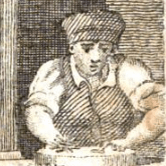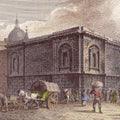
The Work of the Type Founder
What Was A Type Founder, And What Did He Do?
"We shall see nothing of Streatham while we are in town; Mrs. Hill is to lye in of a daughter. Mrs. Blackstone is to be with her. Mrs. Heathcote and Miss Biggare just leaving her. The latter writes me word that Miss Blackford is married, but I have never seen it in the papers, and one may as well be single if the wedding is not to be in print." Jane Austen to Anna Austen-Knight, 1814The first part of the type founder’s business is to prepare the metal, which is a composition of lead and regulus of antimony, melted together in a furnace. In larger foundries this metal is cast into bars of twenty pounds each, which are delivered to the workmen as occasions may require; this is a laborious and unwholesome part o the business, owing to the fumes which are thrown off. Fifteen hundred weight of this metal is cast in a day, and the type founders usually cast as much at one casting as will last six months.
We now come to the letter-cutter; that is, to him who cuts the moulds in which the letters are cast; and he much be provided with vices, hammers, files, gravers, and gauges of various kinds. He then prepares steel punches, on the face of which he draws or marks the exact shape of the letter, and with the pointed gravers and sculptors he digs out the steel between the strokes or marks which he made on the face of the punch, leaving the marks standing. Having shaped the inside strokes of the letter, he deepens the hollows with the same tools; for, if a letter be not deep in proportion to its width, it will, when used at press, print black, and be good for nothing. He then works the outside with files till it is fit for the matrice. A matrice is a piece of brass or copper about an inch and a half long, and thick in proportion to the size of the letter it is to contain. In this metal is sunk the face of the letter intended to be case, by striking the letter-punch. After this the sides and face of the matrice must be cleared, with files, of all bunchings made by sinking the punch.
When the metal and other things are properly prepared, the matrice is fastened to the end of the mould, which the caster holds in his left hand, while he pours the metal in with his right. By a sudden jerk of the hand, the metal runs into the cavity of the matrice and takes the figure or impression.
The mould consists of an under and upper half, of which the latter is taken off as soon as the letter is cast, and the caster throws the letter upon a sheet of paper, laid for the purpose on a bench or table, and he is then ready to cast another letter as before. When the casters have made a certain number of types, which are made much longer than they are wanted, boys come and break away the jets, or extra lengths from the types; the jets they cast into the pot, and the types are carried to the man who is represented sitting at his work in the plate, who polishes their broadsides.
This is a very dexterous operation; for the man, in turning up the tupes, does it so quickly, by a mere touch of the fingers of the left hand, as not to require the least perceptible intermission in the motion of the right hand upon the stone. The caster represented in the plate is seen in the act of pouring the metal into the mould. He takes it up with a small ladle from the pan, which is constantly kept over the fire in a sort of stove under the brick-work. The iron plate on the right hand of the caster is to defend him from the heat of the fire, and the screen between the two workmen is to prevent the man sitting from being injured by the metal, which is apt to fly about by the operation of casting.
On the table near the newly cast types, are several blocks of metal, with which the caster replenishes his pan as he makes the letters. A type founder will cast upwards of 3000 letters in a day; and the perfection of letters thus cast, consists in their being all straight and square; of the same height, and evenly lined, without sloping one way or the other. What is called a found or font of letter, is a quantity of each kind cast by the letter-founder and properly sorted.
A complete font includes, besides the running letters, all the single letters, double letters, points, commas, lines borders, head and tail pieces, and numerical characters. Letter-founders have a kind of list by which they regulate their founts: this is absolutely necessary, as some letters are much more frequently used than others, of course the cells containing these should be better stored than those of the letters which do not so often recur. Thus a fount does not contain an equal number of a and b, or of e and z.
In a fount contacting a hundred thousand characters, the a should have five thousand, the c three thousand, the e eleven thousand, the i six thousand, and the other letters in proportion. Printers order their founts either by the hundred weight or by the sheet. If they order a fount of five hundred, they mean that the whole shall weigh 500 lb.; but if they demand a fount of ten sheets, it is understood that with this fount they shall be able to compose ten sheets, or twenty forms, without being obliged to distribute. The type founder reckons 120 lb to a sheet, but this varies with the nature of the letter.
From The Book of Trades or Library of the Useful Arts, Part I The First American Edition; 1807
Enjoyed this article? If you don't want to miss a beat when it comes to Jane Austen, make sure you are signed up to the Jane Austen newsletter for exclusive updates and discounts from our Online Gift Shop.




Leave a comment
This site is protected by hCaptcha and the hCaptcha Privacy Policy and Terms of Service apply.